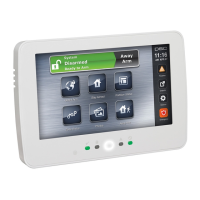
Do you have a question about the DSC hs2tchp and is the answer not in the manual?
Instructions for reducing risk of fire, electric shock, and injury.
Guidance on keeping the keypad in optimal condition and resolving issues.
Advice on how to handle the device without causing damage.
Instructions for cleaning the display and device.
Steps to take when the system displays an error message.
Overview of how the security system components work together.
Information on system design, installation, and user instruction.
Information on monitoring carbon monoxide detectors and warnings.
Information on monitoring fire detection devices like smoke detectors.
Procedure for ensuring the system functions correctly.
How the system transmits alarms and information to a central station.
Guidance on minimum maintenance requirements for the system.
General disclaimer regarding system limitations and professional servicing.
Description of the main display screen and its elements.
Activating the fire alarm function by pressing the Fire key.
Activating the medical alarm function by pressing the Medical key.
Activating the panic alarm function by pressing the Panic key.
Arming the system to protect the perimeter only.
Feature that silences audible exit warnings and doubles exit time.
Procedure to disarm the security system.
Arming the system for when the premises are vacated.
Option to restart the exit delay timer if a zone is tripped.
Period during which an alarm transmission can be canceled.
Audible notifications for specific arming events.
Notification of improper exit when arming in Away mode.
Indication of a failure to arm the system.
Using wireless keys or proximity tags to arm/disarm.
General guidance on operating the alarm system.
Description of different alarm sounds and their meanings.
Details on the continuous siren for intrusion alarms.
Steps to take for an accidental intrusion alarm.
Procedure for responding to a fire alarm.
Information on CO alarm detection and response.
Viewing stored alarm events and sensor information.
Procedure to reset specific sensors after an alarm.
Activating programmed functions via output keys.
Creating a slideshow of photos using an SD card on the keypad.
Function to exit premises quickly while armed.
Procedure for setting the system's time and date.
Option to use the touchscreen as a traditional DSC keypad.
Enabling or disabling the door chime function.
Viewing the status of system zones.
Explanation of icons indicating zone status.
Using the bypass feature to exclude zones from arming.
Procedure for bypassing zones using the HS2TCHP keypad.
Managing user access codes, including adding, editing, and deleting.
Access to installer-specific functions.
Accessing user-programmable system functions.
Controlling the door chime feature.
Viewing the status of system partitions.
Using the touchscreen as a traditional DSC keypad.
Enrolling proximity tags for system access.
Removing proximity tags from the system.
Configuring attributes for user access codes.
Default attributes for user codes.
List of attributes that can be assigned to user codes.
Determining if access codes generate arming/disarming bell squawks.
Assigning users to specific partitions.
Procedure for deleting user access codes.
Detailed access to installer-specific functions.
Procedure to set the system's time and date.
Programming the system to automatically arm at specific times.
Enabling remote access for system servicing.
Displays the date, time, and description of system events.
Testing the system's bell, lights, and communicator.
Enabling or disabling auto-arm and auto-disarm features.
Providing temporary access for service providers.
Procedure for resetting the system after an alarm.
Customizing keypad display and sound settings.
Configuring the layout of the keypad's home screen.
Controlling the door chime function.
Details on various arming modes like Stay, Away, and Night.
Viewing the status of system partitions.
Understanding the concept of system partitioning.
How keypads operate within a single assigned partition.
Temporarily assigning a keypad to a different partition.
Using the touchscreen as a traditional DSC keypad.
Operating multiple partitions from a single keypad.
How fire and carbon monoxide zones affect partitions.
Finding the system's phone number for SMS control.
Registering phone numbers to interact with the system via SMS.
Formatting and sending text messages to control the system.
Reference list of commands that can be sent via SMS.
Performing a diagnostic test on system sounders and lights.
Steps for a comprehensive system test, including detectors.
Initiating a mode to test sensor coverage.
Enabling remote access for system servicing.
Checking if system features like Fire, Medical, Panic are active.
Information for service providers like central station and installer.
Fields for account and telephone number of the monitoring station.
Fields for company name and telephone number of the installer.
Record of battery replacement and service history.
Table for recording system access codes.
Table for recording sensor and zone details.
Recommendations for proper placement of smoke and CO detectors.
Specific guidance on locating and installing smoke detectors.
Specific guidance on locating and installing CO detectors.
Procedure for conducting a home fire safety assessment.
Steps for developing and rehearsing a family fire escape plan.
Terms and conditions for using the software product.
Rights granted to the user for software installation and use.
Limitations on reverse engineering, decompilation, and component separation.
Disclaimers and limitations on DSC's liability.
Warranties provided and disclaimed by the manufacturer.
Information regarding FCC regulations and compliance.
